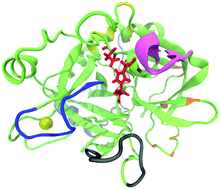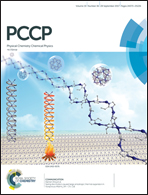Mechanistic insights into thrombin's switch between “slow” and “fast” forms†
Abstract
Thrombin is a multifunctional enzyme that plays an important role in blood coagulation, cell growth, and metastasis. Depending upon the binding of sodium ions, thrombin presents significantly different enzymatic activities. In the environment with sodium ions, thrombin is highly active in cleaving the coagulated substrates and this is referred to as the “fast” form; in the environment without sodium ions, thrombin turns catalytically less active and is in the “slow” form. Although many experimental studies over the last two decades have attempted to reveal the structural and kinetic differences between these two forms, it remains vague and disputed how the functional switch between the “fast” and “slow” forms is mediated by Na+ cations. In this work, we employ microsecond-scale all-atom molecular dynamics simulations to investigate the differences in the structural ensembles in sodium-bound/unbound and potassium-bound/unbound thrombin. Our calculations indicate that the regulatory regions, including the 60s, γ loops, and exosite I and II, are primarily affected by both the bound and unbound cations. Conformational free energy surfaces, estimated from principal component analysis, further reveal the existence of multiple conformational states. The binding of a cation introduces changes in the distribution of these states. Through comparisons with potassium-binding, the binding of sodium ions appears to shift the population toward conformational states that might be catalytically favorable. Our study of thrombin in the presence of sodium/potassium ions suggests Na+-mediated generalized allostery is the mechanism of thrombin's functional switch between the “fast” and “slow” forms.



 Please wait while we load your content...
Please wait while we load your content...